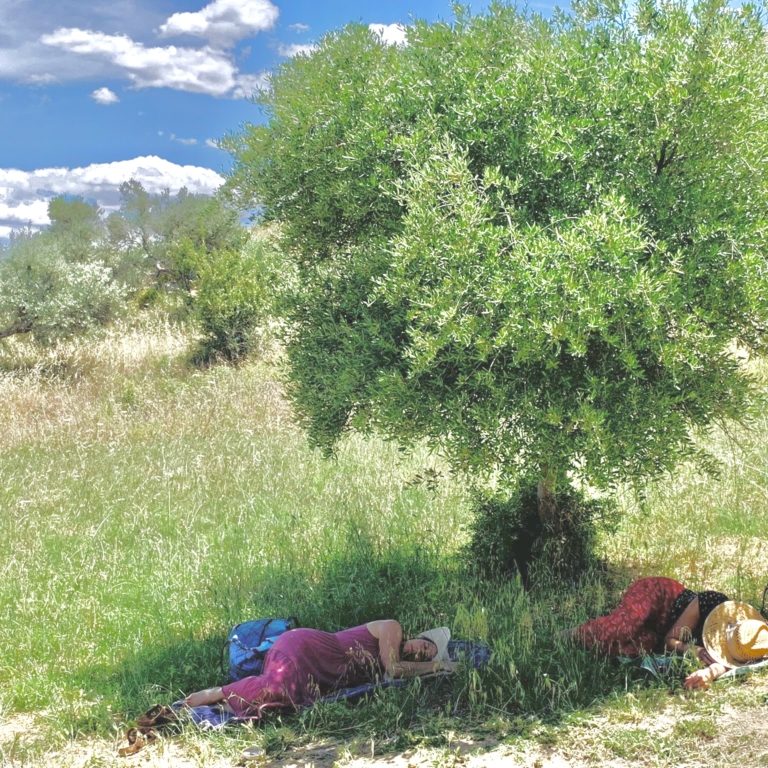Sicilian Plant Pilgrimage
I recognize that traveling internationally is a privilege. I am humbled by the opportunity. If you have never immersed yourself in a completely different culture and there is a chance you can, please do take it. It broadens your perspectives and opens your heart. Sicily also blew my mind.
Instagram is what led me to this trip- following herbalist Jade Alicandro Mace of Milk and Honey Herbs inspired me to sign up for her newsletter which told of Botanico Sacro with Radici Sicilia, led by Marybeth Bonfiglio. The magician Francippo of Madonie Travels pulled all the logistics together for our group of 11 and with his inner island connections, was a dream tour guide. My dear friend Meghan, who is of Sicilian ancestry, came on this trip with me and we were both left speechless for most of it. Marybeth led us to sacred sites and helped us understand the potency of the land and the cultural backbone and then Jade would guide us in plant walks and medicine making and more story of the sacred.
What drew me to this trip were the plant people—A luscious plant pilgrimage opportunity. Olive, Pomegranate, Rosemary, Thyme, Fig, Lemon, Bay, Fennel, Malva, Rose—all whom I love and wanted to meet in their wild habitat. What surprised me was how many plants are wild here that also grow wild in Appalachia. I would not have guessed to see Elderberry, Queen Anne’s Lace, Oats, Chicory, Red Clover, Nettles, Yellow Dock, Cleavers, Prickly Pear, Violet, Astragalus, Pine and so so many more! Except here these plants are huge. The Elderberry has a trunk that looks like a Locust (Robinia) tree! The flower heads of Queen Anne are like large saucers. The Yellow Dock flower stems are as big as corn stalks and Prickly Pear Cacti are trees. Wild Oats grow by the thousands, and were milky and ripe. I don’t know which plants are native to Sicily and I don’t really care. I just loved meeting them All.
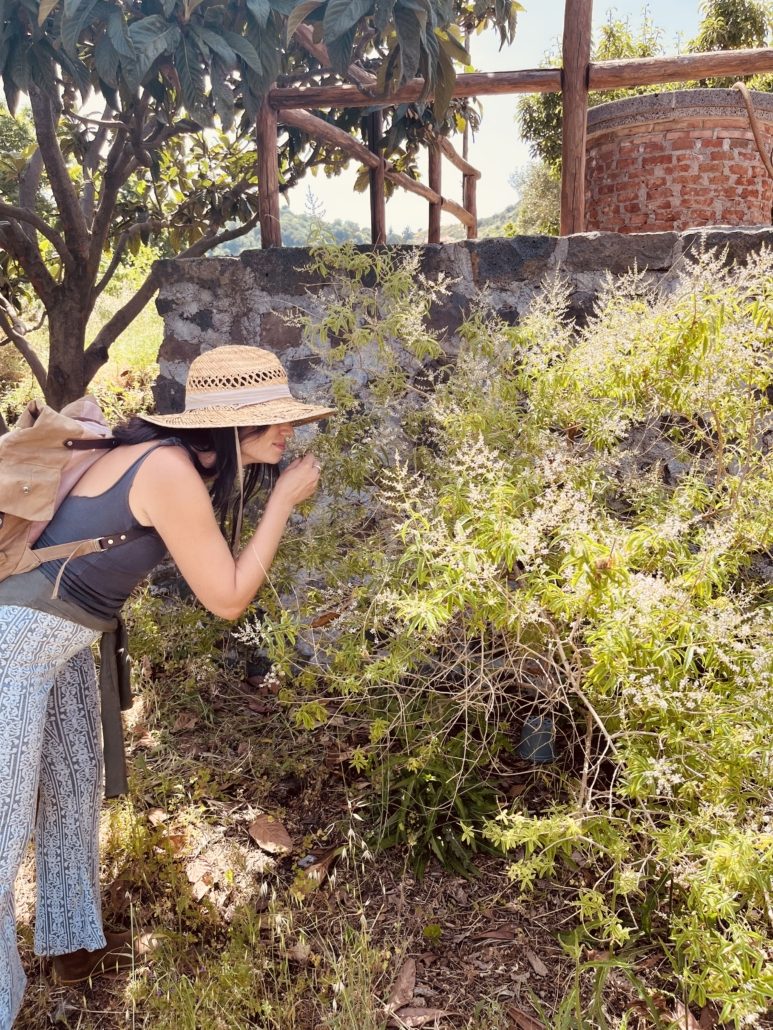
Meghan smelling the biggest Lemon Verbena we have ever seen!
I’m embarrassed to say that other than an idea of the plant allies here, I knew nothing else. I was going to Italy. I didn’t even realize until a week before I was leaving, when Hart said, “You understand Sicily is an island off the coast of Italy,” that I was going to a culturally unique spot— a meeting place of settlements from North Africa, Western Europe, the Middle East and India, all blended into one incredibly diverse and lively culture.
This is another reason traveling is so powerful/ I could never have understood this place through books and photos the way I do now, from the gravitas of actually traversing the soils and soul of it.
I also didn’t realize everyone on this trip would be of Sicilian ancestry except me (and Lynn;-)) They were all coming back here,
to discover
or remember
or reunite
or heal
(or a combo of all the above), all kinds of ancestral stories.
And even though I have no Sicilian or Italian blood that I’m aware of, I was very drawn there and feel a taproot extend from my core that will always reside in this place, long after I’m gone.
After flying into Catania, a city lined with psychedelic purple-flowering Jacaranda trees, we collectively initiated our journey by climbing a part of Mt. Etna that is only accessible with a guide. Black lava rock mountains beckon you closer—some faces completely bare and others covered in rare endemic plants that reside on the fertile black soil built by centuries of lava flow.
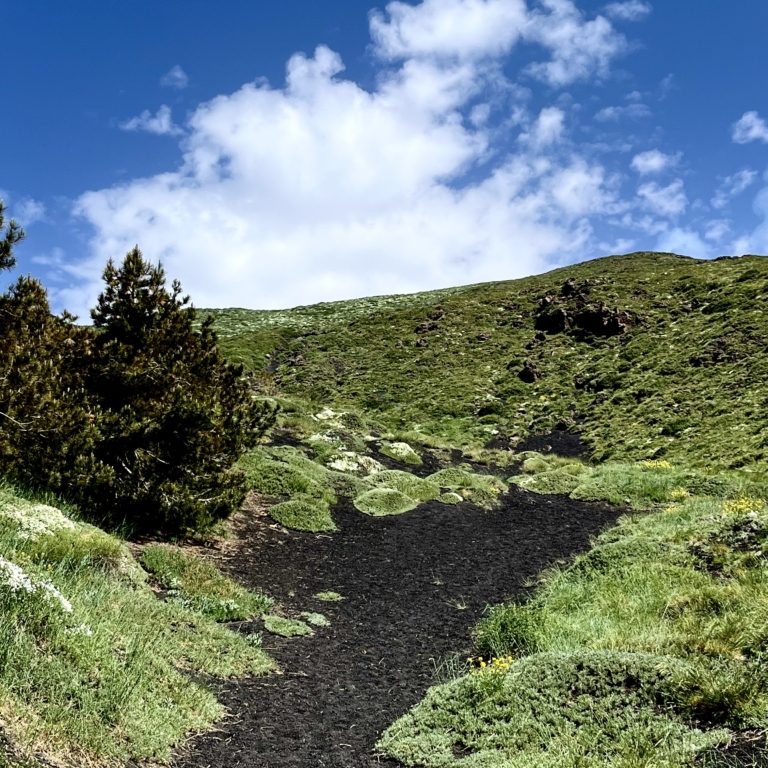
The varying zones of altitude create different tree communities, like birch, chestnut, broom, oak, and pine, and above the tree line dozens of plant species congregate. Etna is one of the planet’s most active volcanoes and is constantly spouting out something, though at times greater than others. As recently as 2003, Etna sent her ash all the way to Libya.
How exciting to begin the hike by eating an endemic buckwheat family plant called Rumice (Rumex scutatis) that tastes like sheep sorrel, and Yarrow, who had both different foliage and smell than the one I know. There was Violet (Viola aetnensis) blooming purple; Cerastium tomentosum, a chickweed sibling, in flower; Tansy at higher altitude (we hiked over 6000 feet); and the one that stands out the most, “The Queen”(Astragalus siculus), aka the Holy Thorn, because she blankets the mountain with protection (her thorns are like little knives) and takes the snow and rainfall deep into her meter-long roots and holds that moisture in the surrounding soil so that other plants will have a chance to grow, too. The Queen was just beginning to flower, purple-pink blooms along her spine.
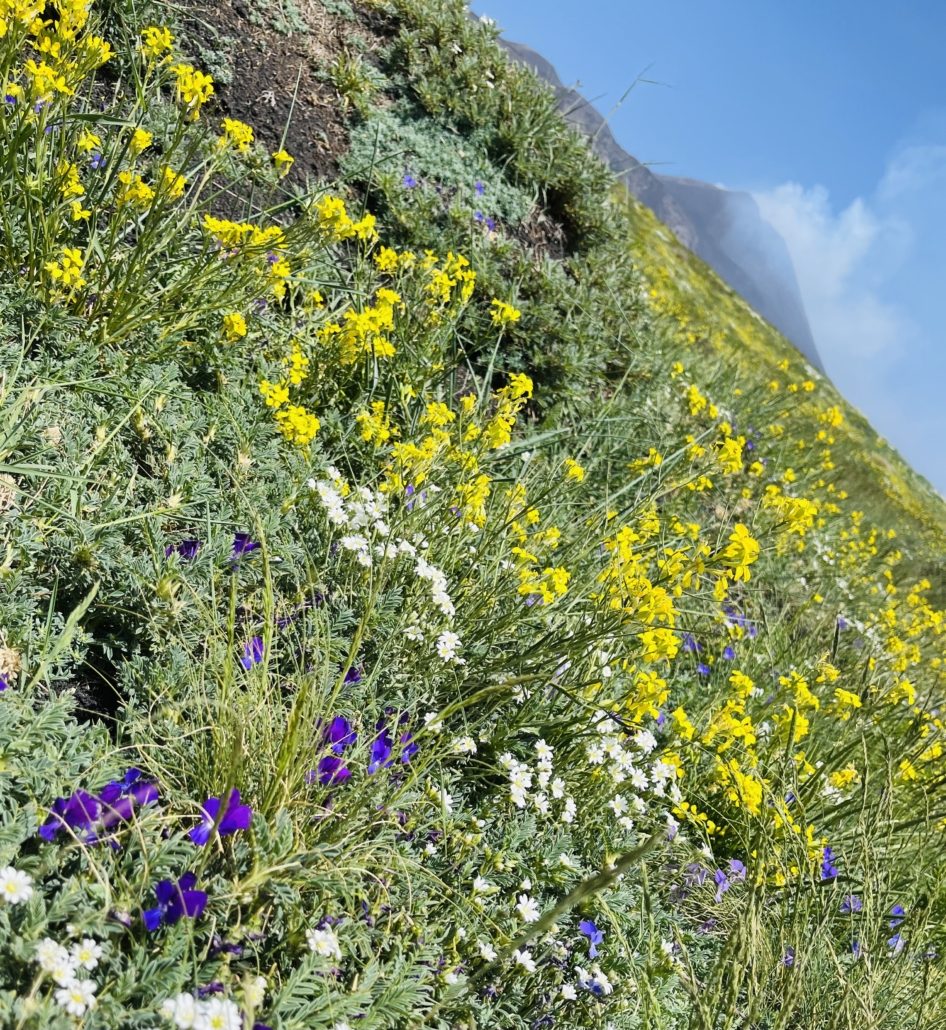
Etna always smokin’, with Wallflower, Cerastium and endemic Violet and Astragalus in flower.
At the peak of our hike, we sat and remembered the past, where we’ve come from, and felt into the power of this living volcano. I gave Her some of Frank’s ashes, a place I know he’d of been delighted to experience. We could have all stayed there much longer, but we soon learned that we felt this way about everywhere we went—And there was only so much time to see SO many things…
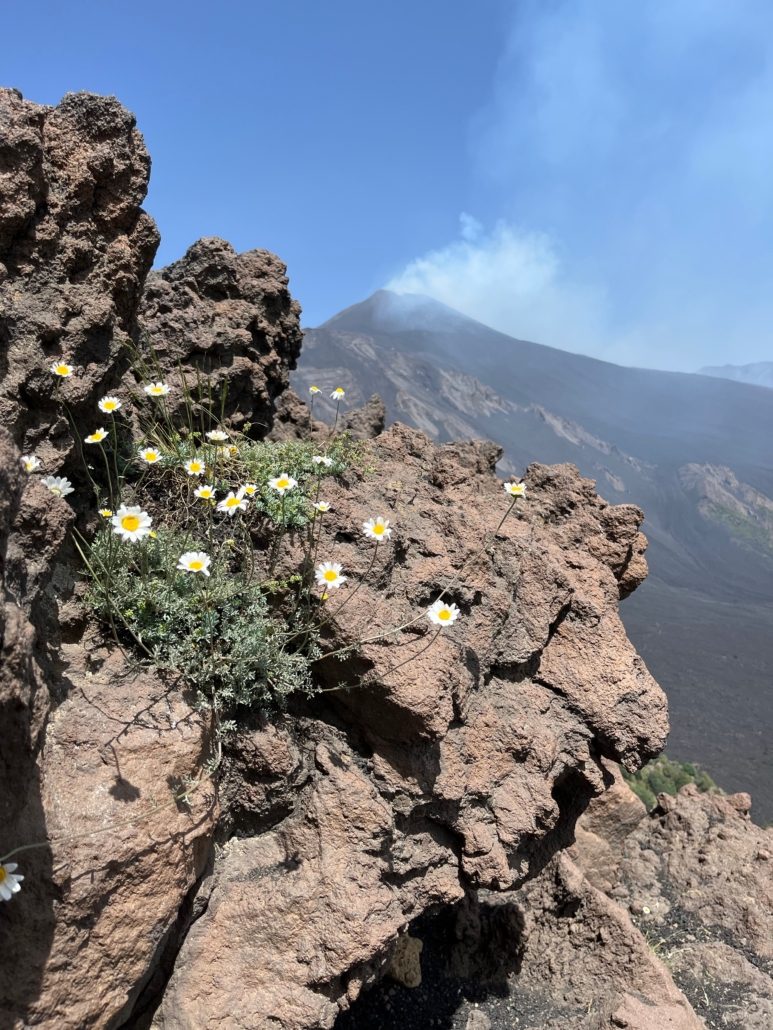
Gave some of Frank’s ashes here to live with volcano and wild chamomile
Montana Grande, a combo of old Sicilia and new, with honey and wine flowing abundantly into our hands and mouths, was our lunch spot after Etna, and that was where I began to learn how Sicilians eat. Course after course. Pasta everyday. Meals mean relaxation and enjoyment, no such thing as fast food, take-out or to-go boxes. You feast there and you take your time doing it.
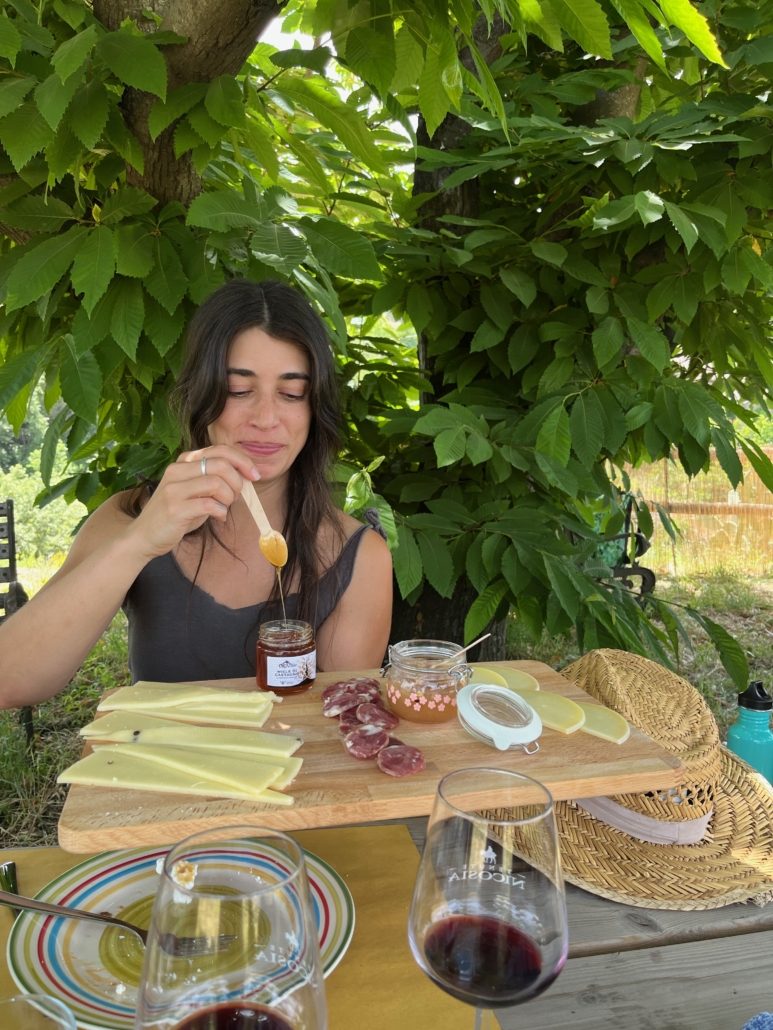
Learning how Italians eat:-)
We landed at Villa Raino, in Gangi, our accommodations for the majority of the trip, with Aldo and Patricia as our hosts, and their daughter, whose name I am forgetting but who I swear was Lady Gaga in some humble disguise. Some of the rooms had quite the art:

I loved that place! I loved the sound of the sheep bells as they grazed all day and night; the pigeons who cooed continuously; the circle grove of Cypress trees where we laid our rocks to call in dreaming together; the wild, big weeds around the brick villa; the personality of Aldo who was like a fun uncle; and the fresh air that cleared my mind.
The next morning, we headed to Morgantina and had it to ourselves, the last Sicilian town to be captured by the Romans and what is now a deserted archeological site. We found silent nooks (not hard to do in this skeleton of a city) to make flower essence of the one who called out to us most strongly. I saw Viper’s Bugloss (Echium vulgare) hugging the sides of the trail and knew immediately that it was the one for me. Borage is my spirit flower and so her family, Boriginaceae, speaks loudly wherever I go. Flowers starting out blue then turning purple into pink speak of change being the only constant; that everything is temporary—both pleasurable and hard experiences.
Other friends hanging out there, century after century after human abandonment, are Papaver rhays, Nepeta nepetella, Sumac, Malva trimestris, Tree Wormwood, Wheat and Oat, Queen Anne’s Lace, Pomegranate, Olive, Fig, Bindweed, Fennel, Wild Asparagus, Rubus spp., Willow, Fica de India which is the Italian name for Prickly Pear, Asters, Oleander, Almond, Locust.
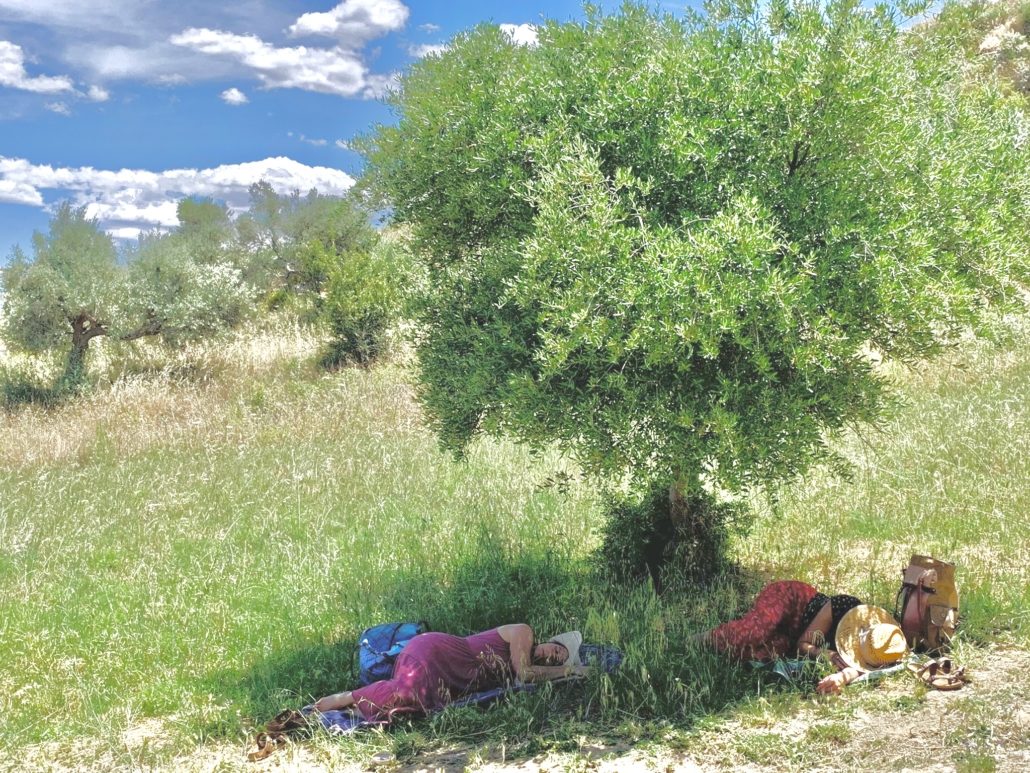
Napping under Morgantina’s olives while our flower essence soaked.
Each day for me was an experience of a lifetime. In Gangi, we met a basket maker named Rosario, aka Sariduzzu, who was a master of weaving the willow and cute as a gnome.
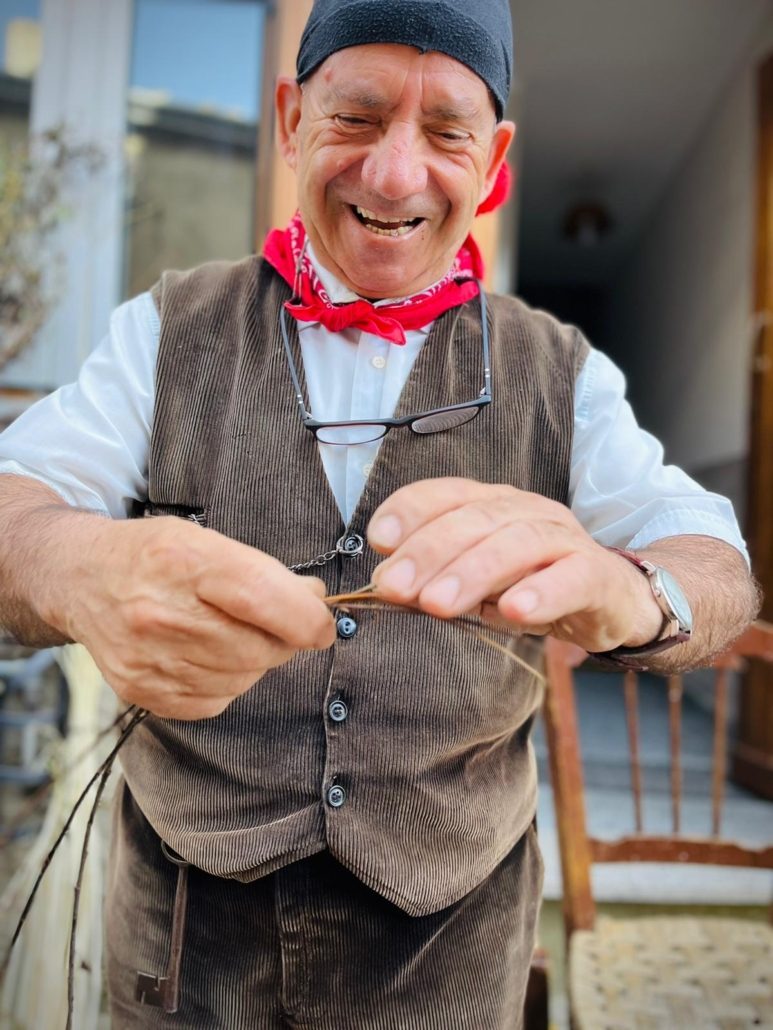
And at the workshop La Capra Canta (The Singing Goat because of the materials he uses) of Fabrizio Fazio, l’artigiano del Tamburo, whose relationship with the frame drum, as both craftsman and artist, had us captivated and all wanting to take home one of his famous drums. I sincerely felt if the trip was over that day, I would have been complete, I was already so full. But it was just beginning.
We went on to a magical place called Giardino Museo A Gisa, who welcomed us with smells of roasting vegetables, processing garlic, beauty in every direction of the land, and a Fava harvest opportunity. Marybeth shared how Fava saved the lives of Sicilians when they were forced to hide inland.
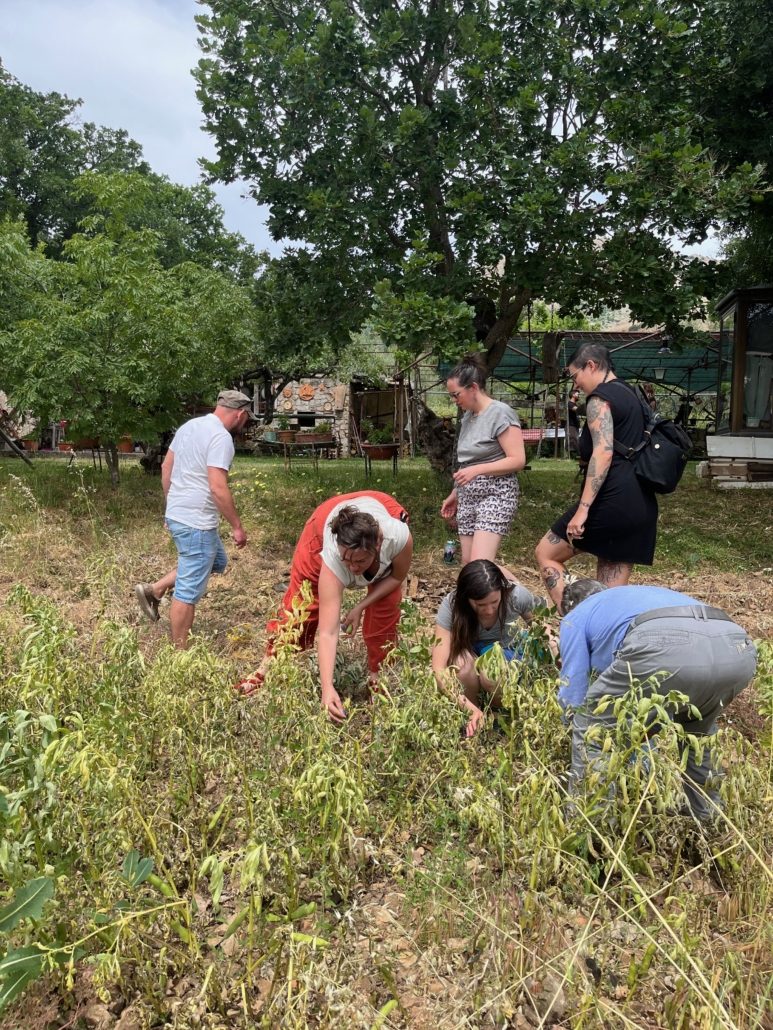
Harvesting Fava
Dario, the son of this family who is turning the farm into a learning and lodging center, and his mom, made an exceptional spread of traditional Sicilian dishes: caponata, freshly-made ricotta, bruschetta, fish (the name of the dish I cannot recall), more cheeses with borage flowers, Pasta with Fava, and eggplant in tomato sauce. We learned that Eggplant Parmesan is not Italian- sounds like the game telephone and Americans got the wrong memo. It is Eggplant Parmiciana! Parmiciana is the Sicilian word for blinds, or the strips that form a window shutter and the dish was named after that, because you overlap the fried eggplant. There is no cheese involved!!!
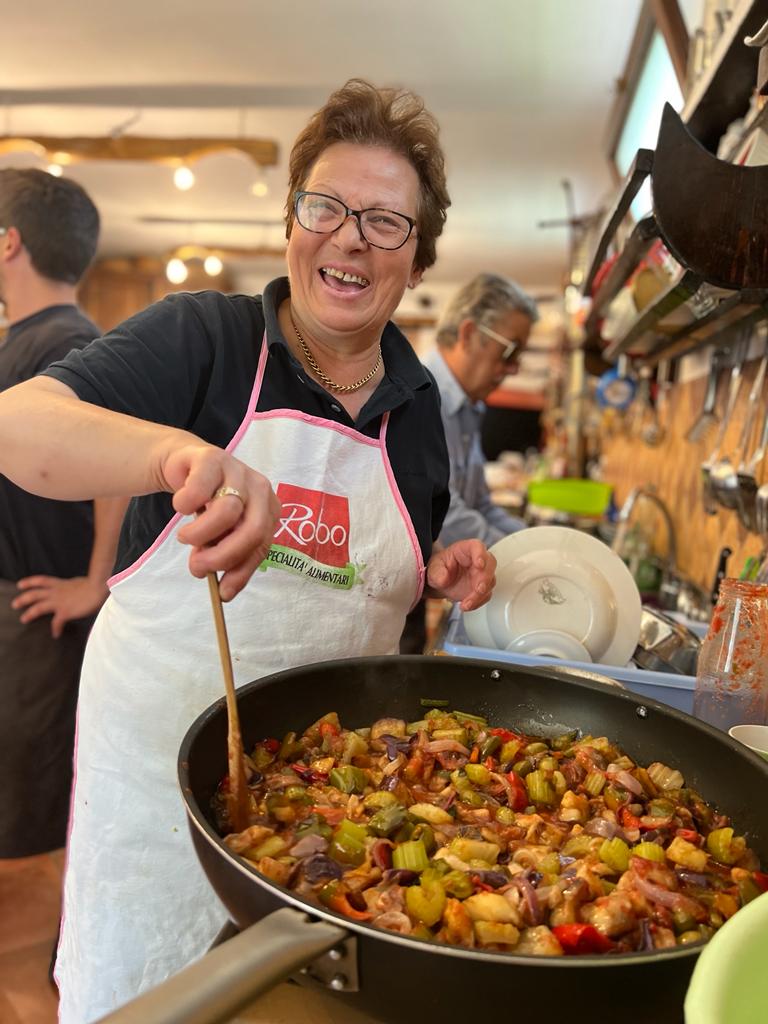 They had a young olive grove, only 100 years old. Growing out of millions of rocks. Plants grow out of walls and rocks here. Walking among the grove, I collected wild flowers: Oats, some mysterious grass and Briza maxima, Chironia flowers and this beautiful dandelion- like flower that was neon yellow. Then I took a nap under an Olive and made a flower essence with its small, cream florets.
They had a young olive grove, only 100 years old. Growing out of millions of rocks. Plants grow out of walls and rocks here. Walking among the grove, I collected wild flowers: Oats, some mysterious grass and Briza maxima, Chironia flowers and this beautiful dandelion- like flower that was neon yellow. Then I took a nap under an Olive and made a flower essence with its small, cream florets.
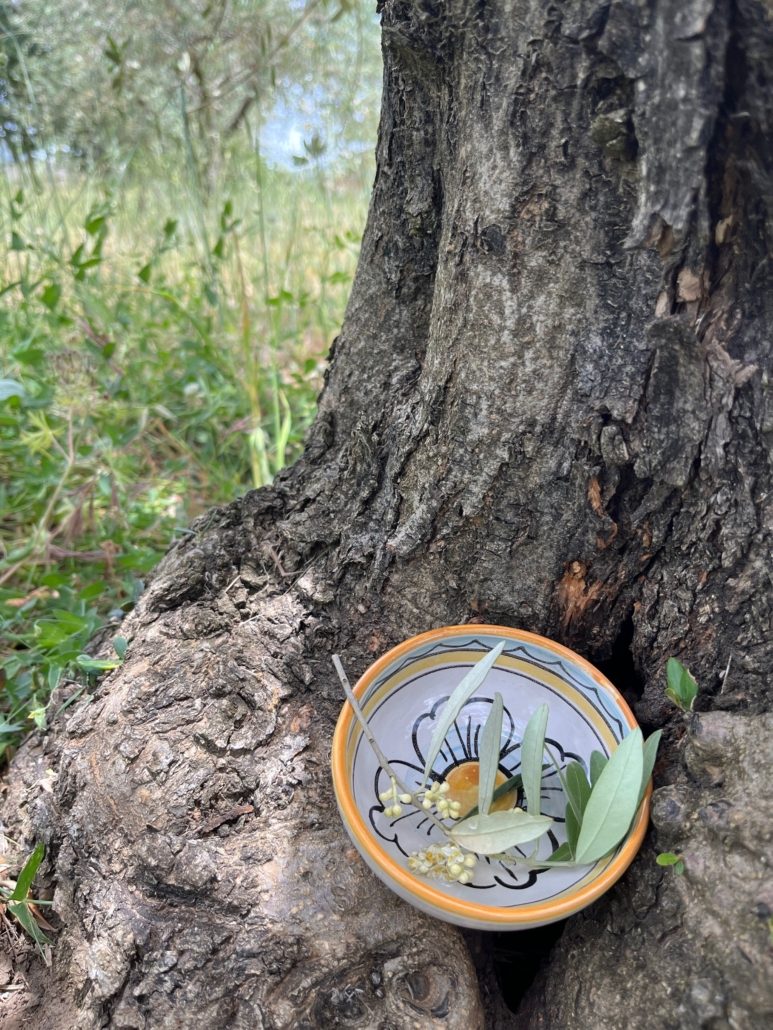
Making an Olive Flower Essence
Things that stand out to me culturally about Sicily are the gray towns perched on the hillsides, entirely built of stone; the fountains in every village, with water pouring out of Naiad mouths; the way I never saw an accident even though the traffic had a crazy-chaotic rhythm to it; no obesity; that the milk and black tea options suck; the open and consistent humor; how people sound like they are screaming at one another but it’s just normal conversation; the ornate churches everywhere; how everything shuts down from 2ish for several hours for siesta; that dinner starts at 9 and can easily go until midnight with 4 or more courses, jugs of wine and everything served family-style and always there is pasta pasta pasta! I loved seeing the stone dwellings and how simple yet beautiful the functional needs of homes are met. And that there are shrines to madonnas and saints and Jesus at most every house, built into a wall.
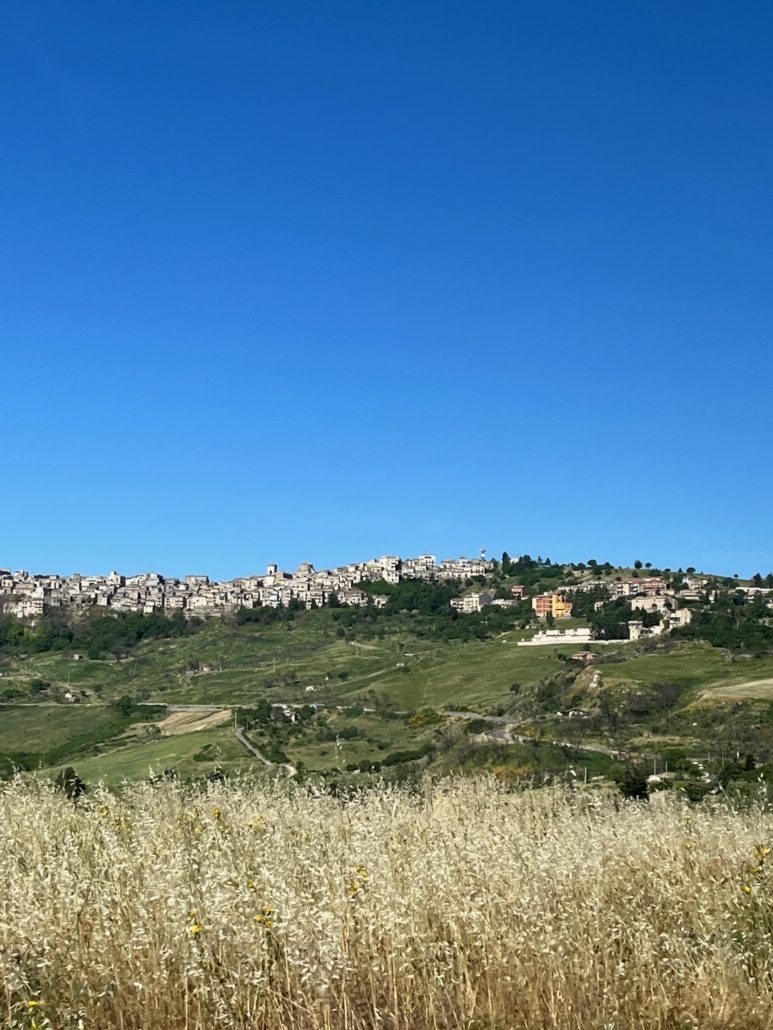
Towns pop up in stone, among the wheat and springs
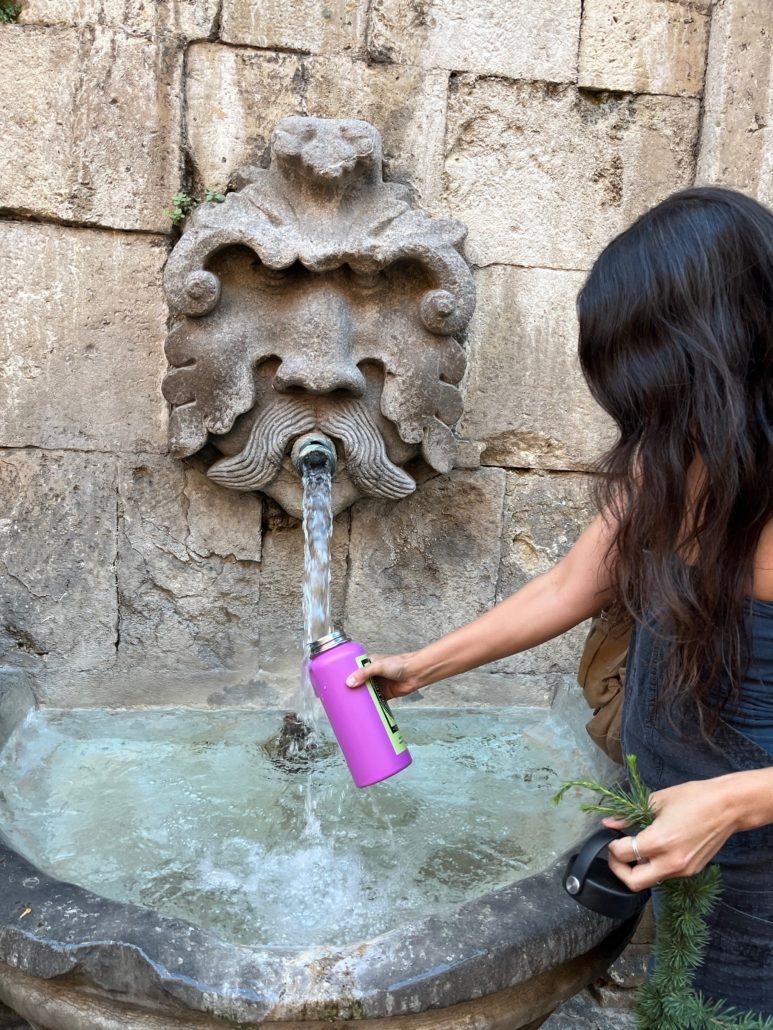
Village fountains
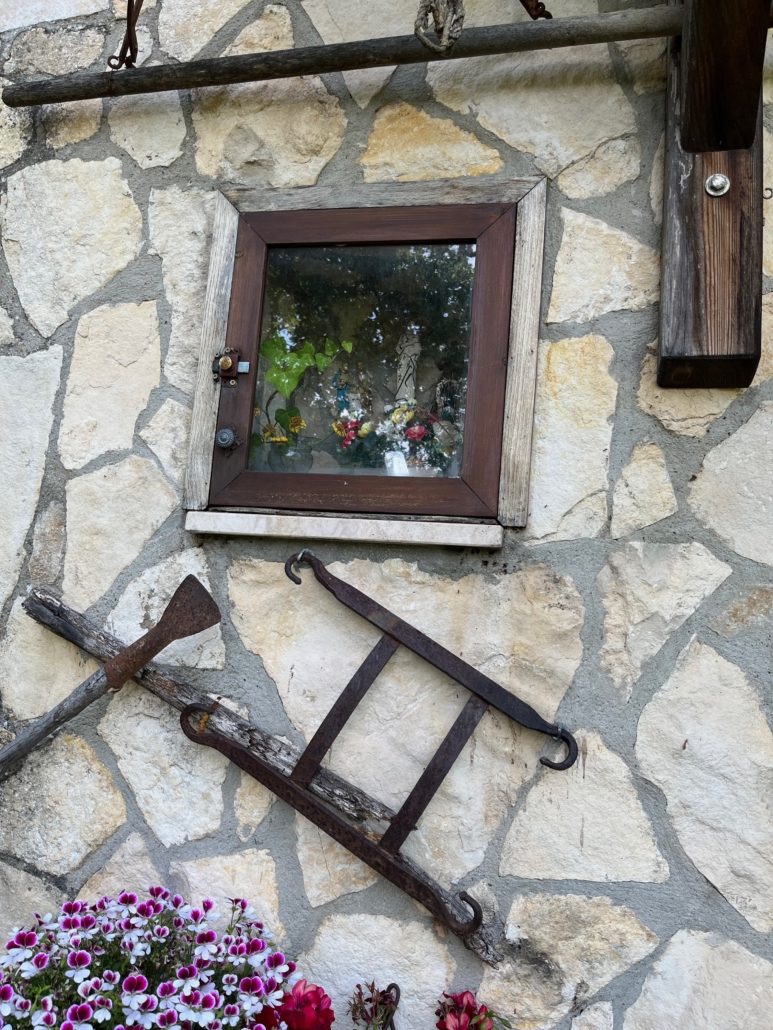
Shrines to Saints built in the walls of houses
Madonie was my favorite place of all. Those mountains are something else!
Magical.
Peaceful.
Stone Pine, Pinus pinea, is the Pine elder of this island, growing like an umbrella.
Saw Virginia Creeper creeping up stone walls- why was I was surprised to see her?
And I had my first gelato, next to the Morgantina museum, and asked for vanilla. The barista said the closest thing he had to vanilla was manna. I didn’t know what that was, other than the thing that God dripped out of the sky for his Israelites upon their 40 year exile.
Well, this manna gelato was delicious!
Then, a few days later, when we were making Kaphi (a traditional Sicilian incense), Jade introduced us to manna- a tasty medicinal resin from the Ash tree! And then we went to a man’s land who grows Fraxinus ornus and angustifolia for harvesting the manna. Only 20 people produce this in the world, the trees being endemic to Madonie.
A kind man named Mario led us up a very, very steep path to his manna farm, and along the way showed us dozens of plant allies: Wild Pistachio (Pistachia lenticus) aka Mastic; Erica arborecea which, like olive, pipe makers use the root of to make pipe heads; Rowan (Sorbus ); Rock Rose (Cistus mosperiensis) and so many of the other plants I’ve already mentioned.
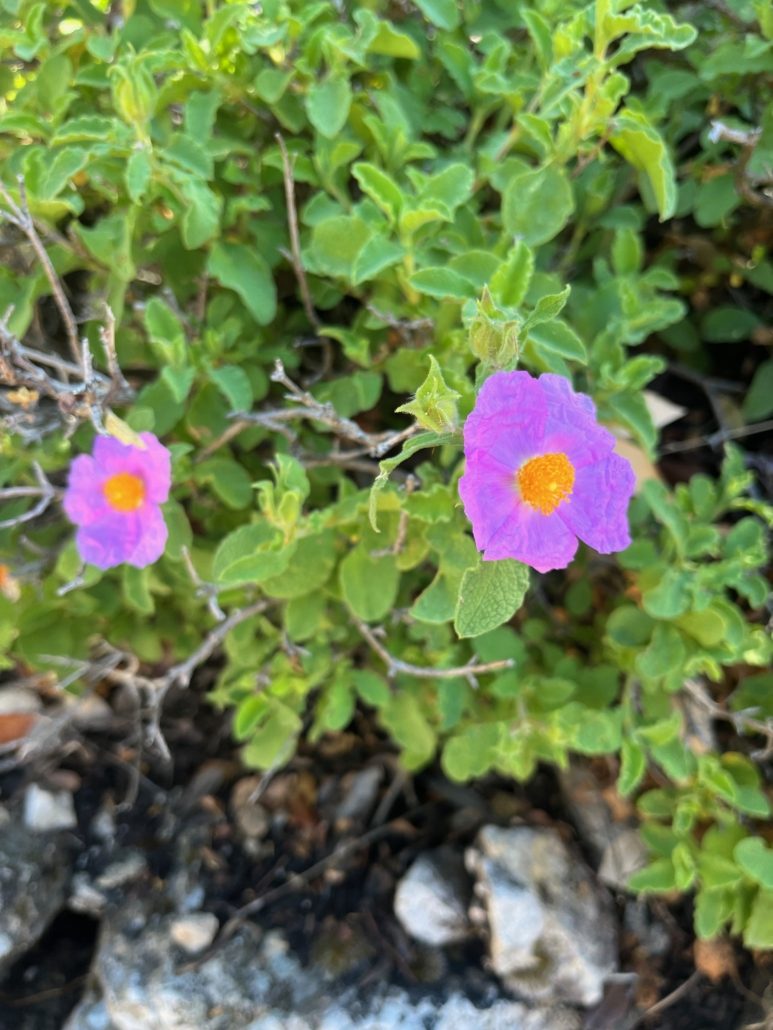
Rock Rose (Cistus mosperiensis)
Mario showed us how he cuts the Ash tree when the time is right, which the ants tell him by their behaviors, and for two months in summer he collects the sap and sells it for elixirs, flavorings, medicine and food. You can live off the manna if you had to- it has that many nutrients and balanced sugars to keep you going.
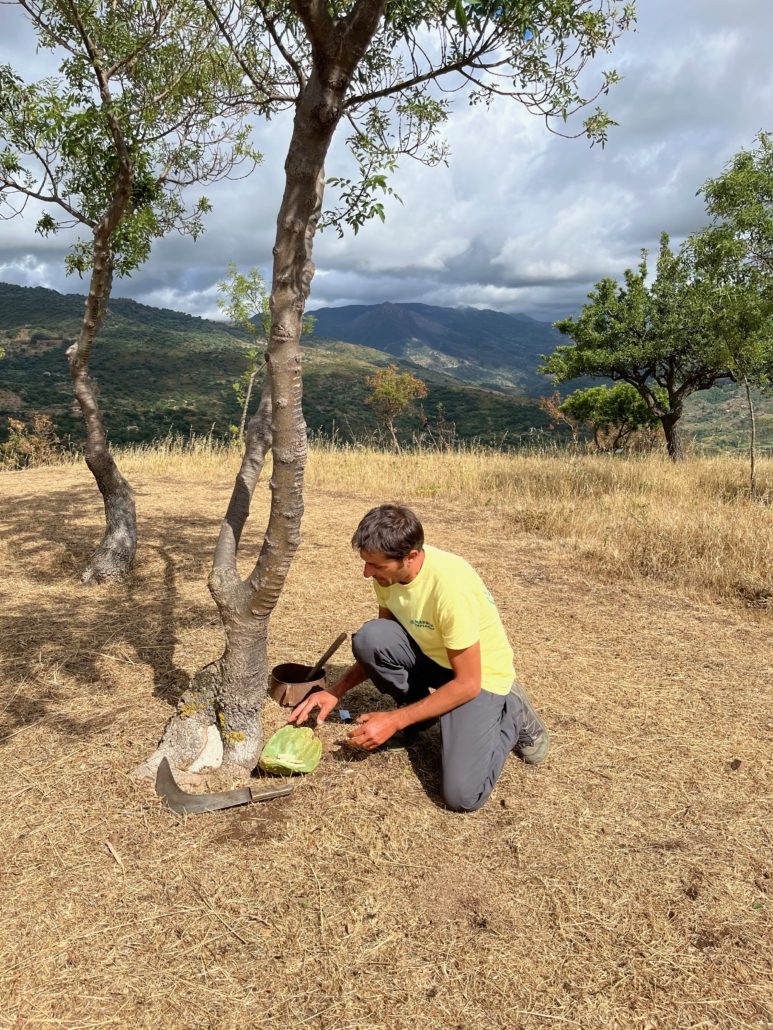
Mario demonstrates how he processes the Ash trees to get Manna
Mario and his wife added hot water to the manna for a face mask. My skin felt like satin afterwards. They also made a Calendula- St.John’s Wort salve with us from both herbs and olive oil grown on their land. What a special place!
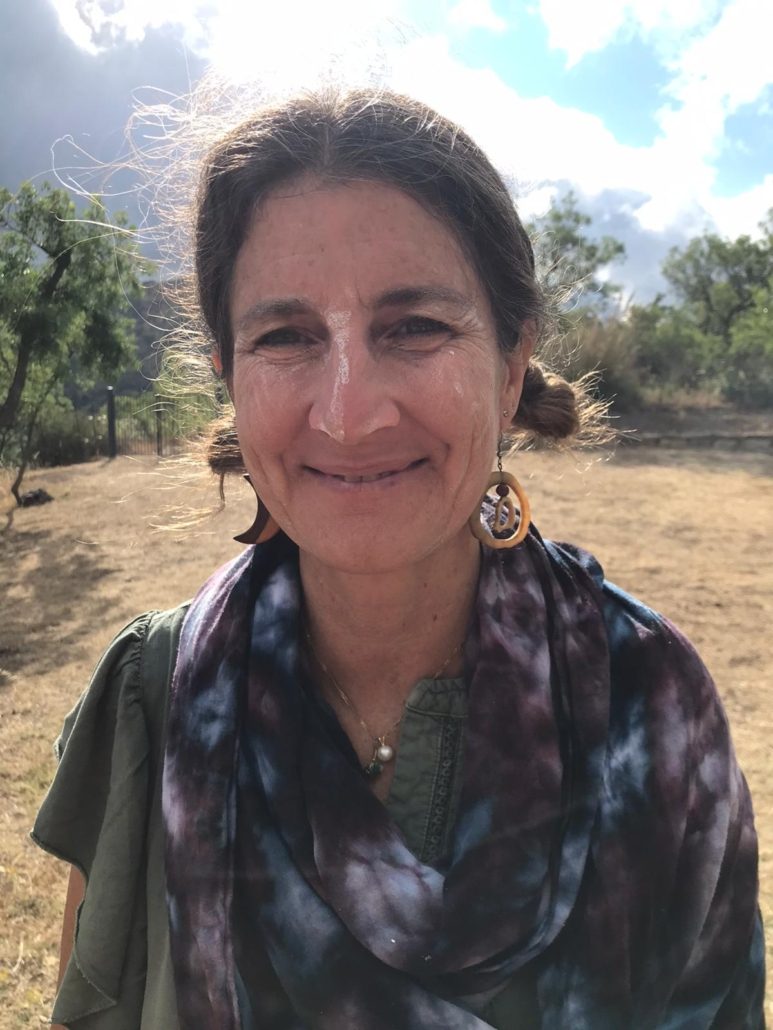
Me and Manna
Onward. We met the owner and host of a 400-year-old teaching garden adjoined to a house museum of Sicilian life, with artifacts, demonstrations and old relics displayed on several floors of an old cottage, in Petralia Sottana, enthusiasticly welcomed us. The teaching garden was alive with spirit. Even though I could not speak Italian and the man who stewarded this place could not speak English, we spoke latin plant names which helped bridge the gap of any mystery plant. Walking along the cobblestones, I turned into a secret garden that had been growing Clary Sage, Rue, Malva, Sage, Rose, Fig, Rosemary, Lavender, Mint and more, from the same seeds or root stock, for centuries! People have come here since the 1700’s to touch, smell, taste and make medicine from the plants that are beloved healers of Sicily. The plants were taking care of themselves and I met the largest cheese mallow I have ever seen, basically a tree!
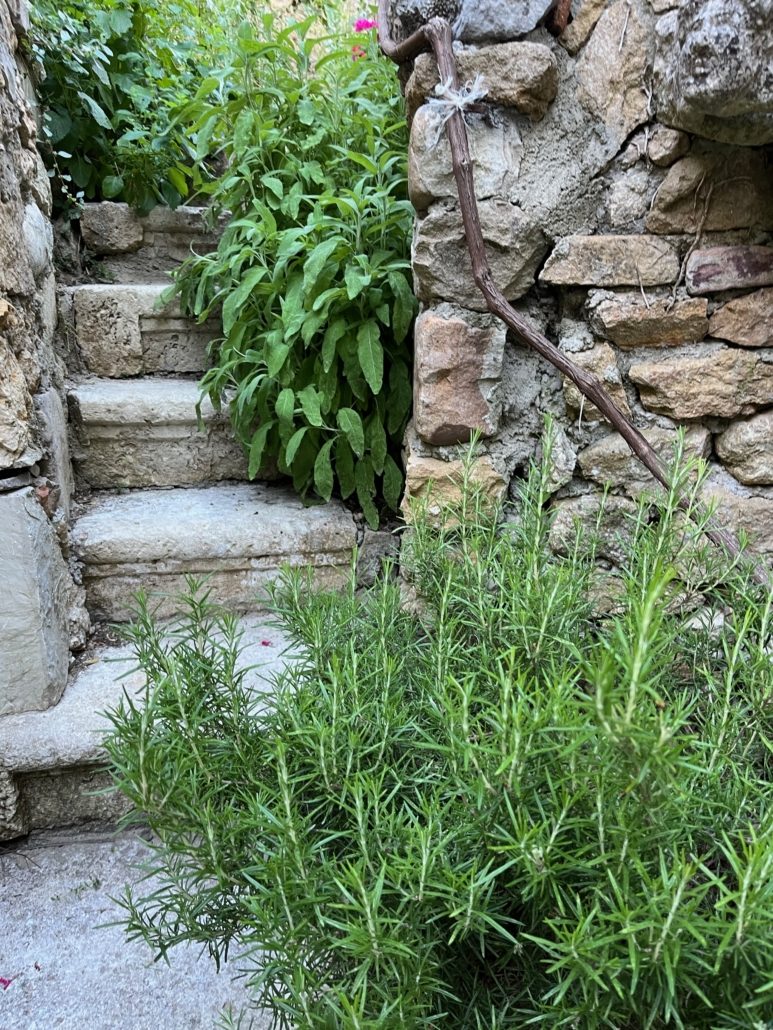
Entrance to the Teaching Garden
And on this Botanico Sacro trip, I did the most beautiful hike of my life so far– I have done thousands of hikes so this is saying a lot. I’ve never walked through so many ecosystems in one 8-mile-stretch, and certainly haven’t come to the climax of a hike in such a sacred manner. We were on a small pilgrimage to Madonna del’Alto’s sanctuary.
Madonna del’Alto, like many of the saints in Italian culture, arrived mysteriously and chose where she would like to live. Radici Siciliane has a great blog post about del’Alto’s her-story. She has been blessing the highest place in Sicily and calling pilgrims from all over the world since her temple was built in the 14th century.
To get there on foot, we started by entering an evergreen/hardwood forest of Chestnut and Pine, Maple (Acer camprantsta) and Oak, in silence and fully mesmerized, following a guide who, once again, only shared one common language and that was botany. It was so quiet and cool and still, I could not help but feel like I was inside of a fairy tale. In between the forests were trails along small cliffs of limestone escarpments, with plants like Packera, Sanguisorba, Coltsfoot and Astragalus nebrodensis. Then we would enter another forest- this time a thick grove of miniature Beech trees, spilling their cache of nuts onto the ground. Then out into the open again seeing Red Clover, Dog Rose, Wild Scabiosa and Wild Thyme covered in flowers with bees madly drinking their nectar. We were told this was Porcini land in September. But right now the plants were flowering abundantly and I couldn’t stop saying OMG.
There was one particular plant that kept speaking loudly to me, one with lavender-like leaves and a white flower that clearly looked like it was in the Borage family. Our guide did not know this one. He seemed to know everyone else- how could he not know this one? To me, it was the most powerful plant on the hike! I took a photo of it and later Marybeth was able to find someone who could identify it. Onosma echioides. Viperina comune is its Italian name. When I look at photos of it or think about it, I get a lively feeling, a stir of excitement.
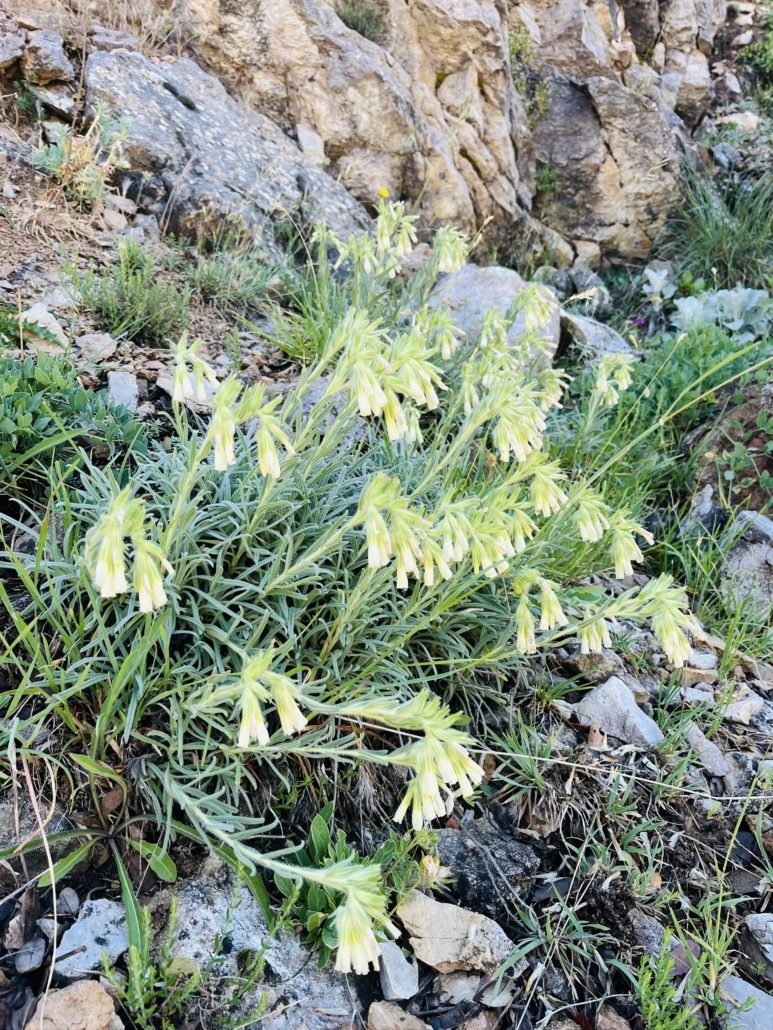
Onosma echioides, or Viperina comune
Asphodel patches in full flower, living next to Star of Bethlehems, were a great joy to meet! Hart had grown this plant from seed in our mountain garden where it could never be as happy as here in its native habitat of dry, rocky, Sicilian-arid clime. Another truly magnificent plant. This hike was orgasmic for me.
Physocarpus kept popping up here and there, with Silene spp., Plantain (Plantago humilis) and Menthe spp. in between their shrubbery. Next, we were among the forest of Abies spp. and were able to see the rare and endangered Abies nebrodensis, the Nebrodi Fir or Sicilian Fir, who are being actively protected in Madonie. I felt the pride our guide had in introducing this species to us, and here he broke out some bread and marmalade and honey and we feasted. We saw some Wild Peonies and Blue Cohosh near these special tree beings.
Continuing on, this hike had us passing some large screes that looked so suddenly out of place, like someone had just hauled them all up the mountain on the backs of donkeys. For a bit we plateaued with Sage Leaf Rock Rose, and Queen Anne’s Lace that flowered red, and sunshine blooms on Saint John’s Wort and seemingly endless patches of golden-flowering Genista cupanni, the famous broom plant of Italy, before traversing into one more forested ecosystem.
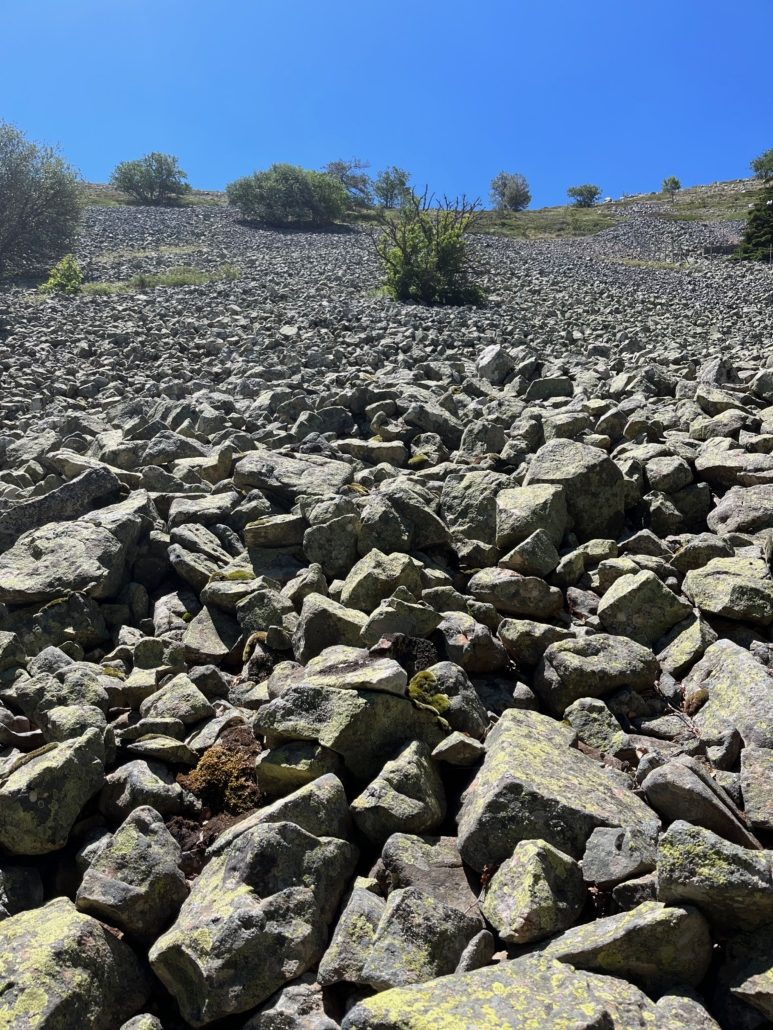
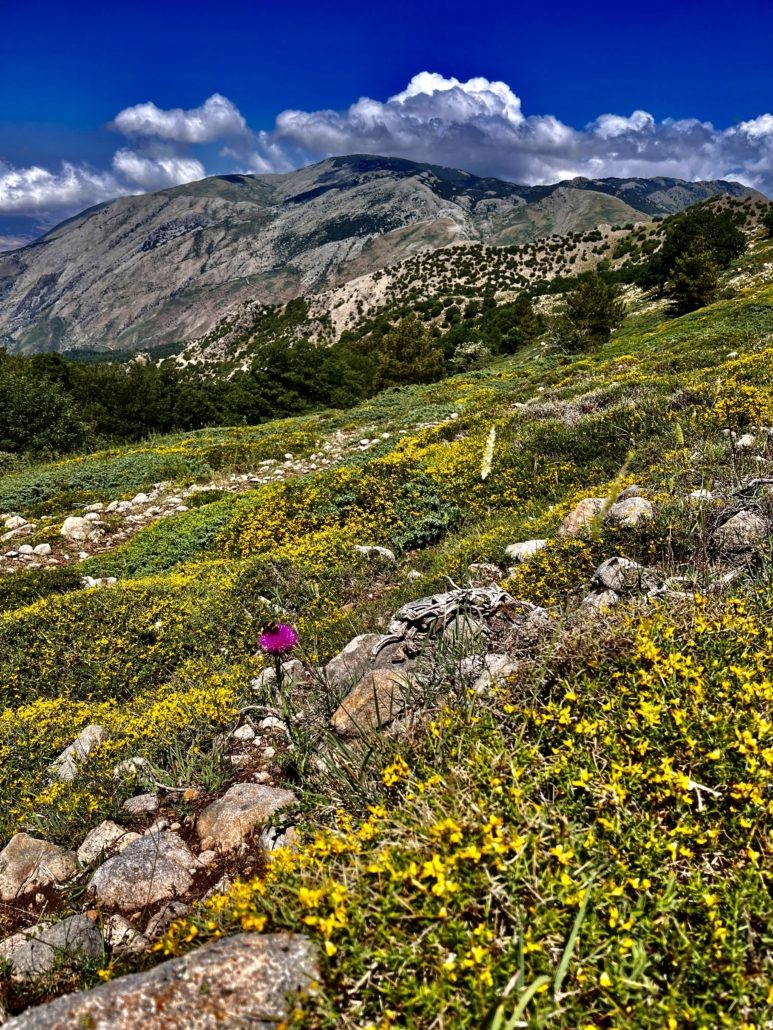

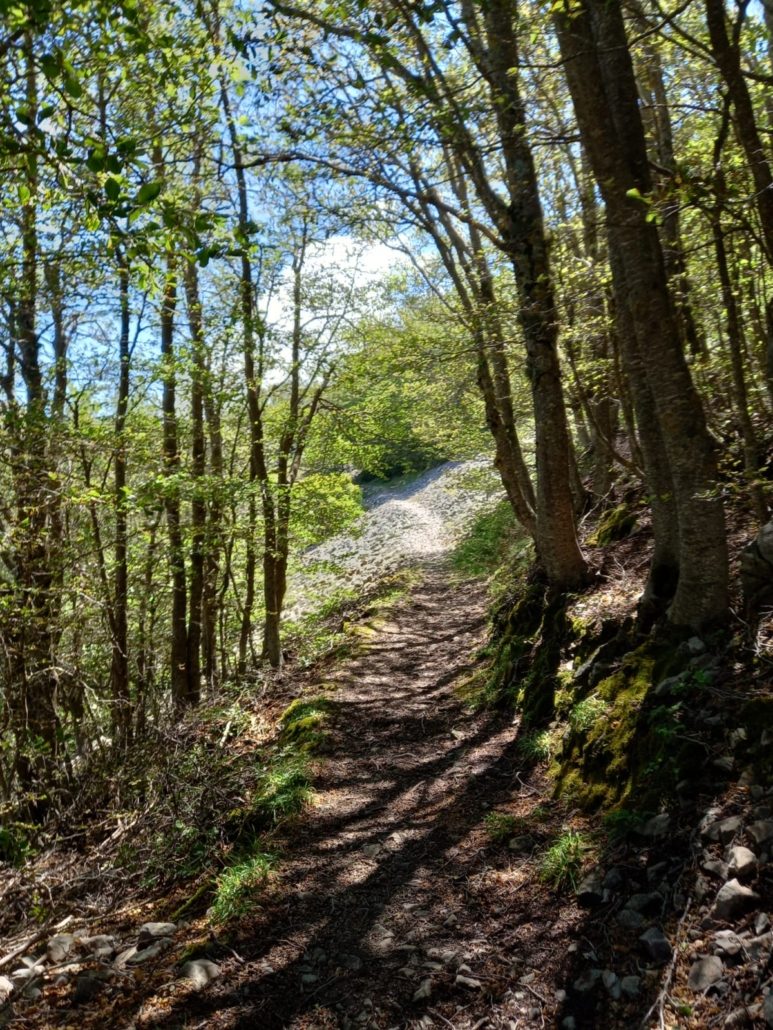
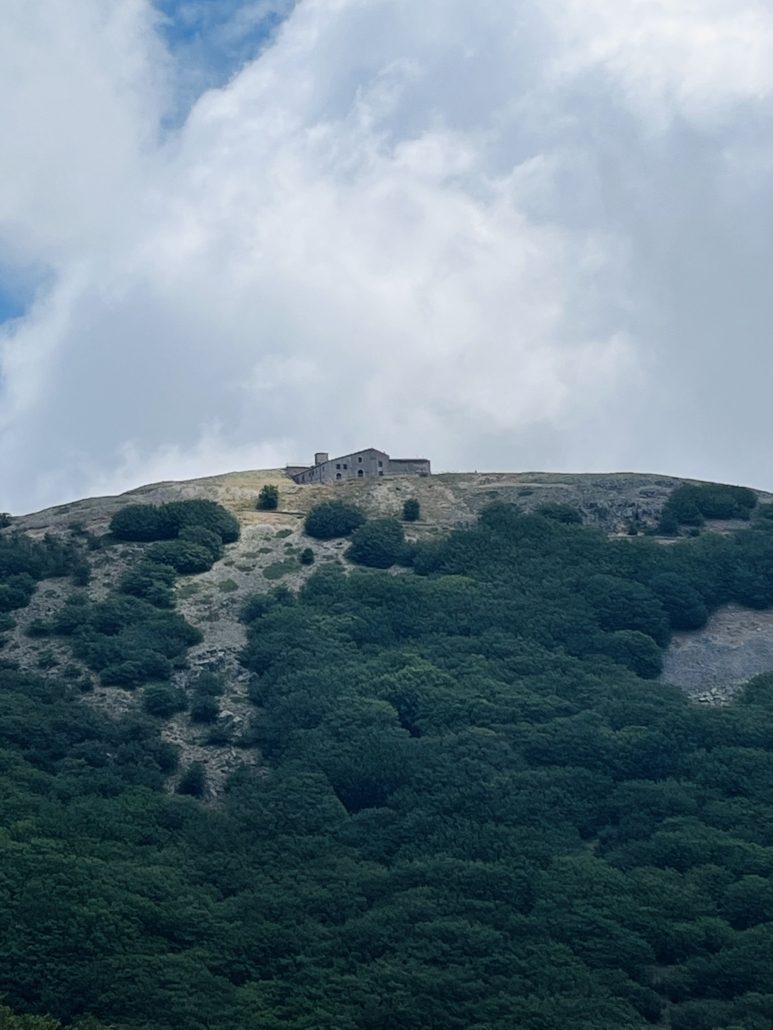
We were now on our final stretch, coming to the holy fountain to choose a rock, wash it and place it in our mouths to silently ascend the last 1/4 mile to the Sanctuary of the Madonna. One by one, our group made it to the top, let the rock drop from our mouths into an Angel statue’s bowl, and found a seat in the sanctuary and let our prayers flow. We spoke aloud the names of those whom we cherished, whom we wanted protection over and blessings upon, and spoke our heart’s song in silence, all at once, before this Madonna, where thousands of people over the centuries have done the same.
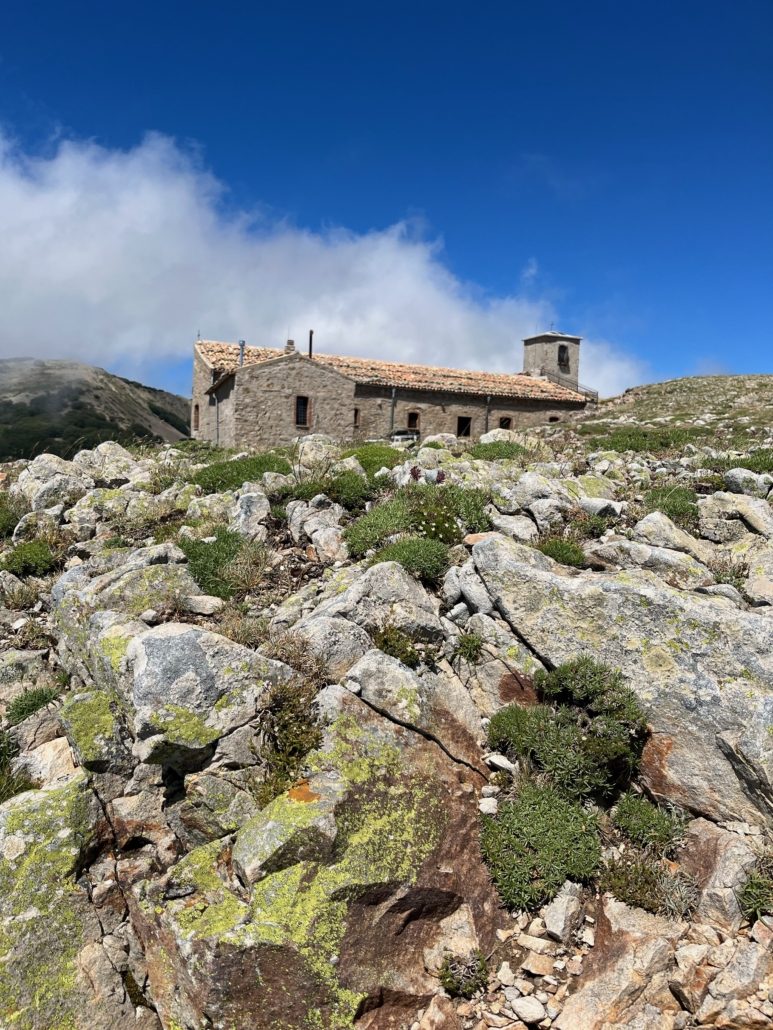
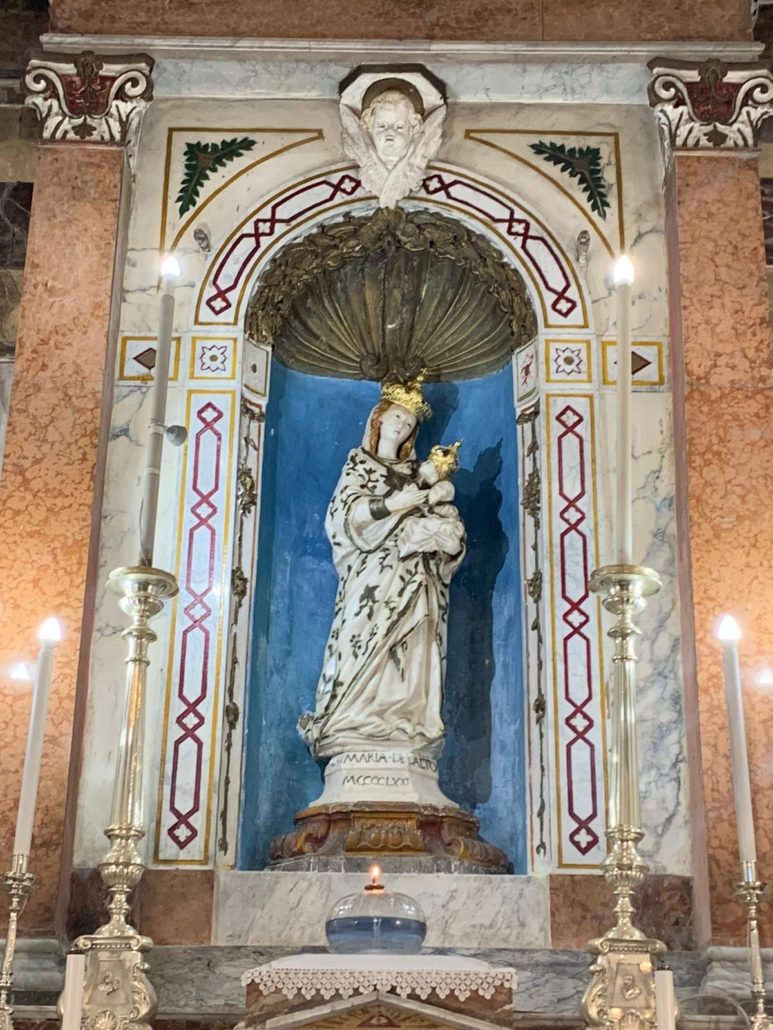
Then elders who volunteer atop this wind swept, middle of nowhere holy pilgrimage site, called us to lunch and we feasted upon their generosity. Such a jubilant occasion- it felt like a family reunion except we didn’t know any of these people. For dessert, they served us the beloved Sicilian pastry called cannoli, and it was over the top! I am still fantasizing about those delicious cannolis!
We took 4-wheel-drive jeeps down the mountain, and made it back to our last evening at Villa Raino, just in time for dinner at 9pm and then some entertainment with traditional Sicilian musicians and renowned storyteller, so animated and full of presence!
And then off we sped the following morning, to visit the Black Madonna of Tindari and her Nature Preserve, leaving the magic of the Madonie Mountains as but a memory.
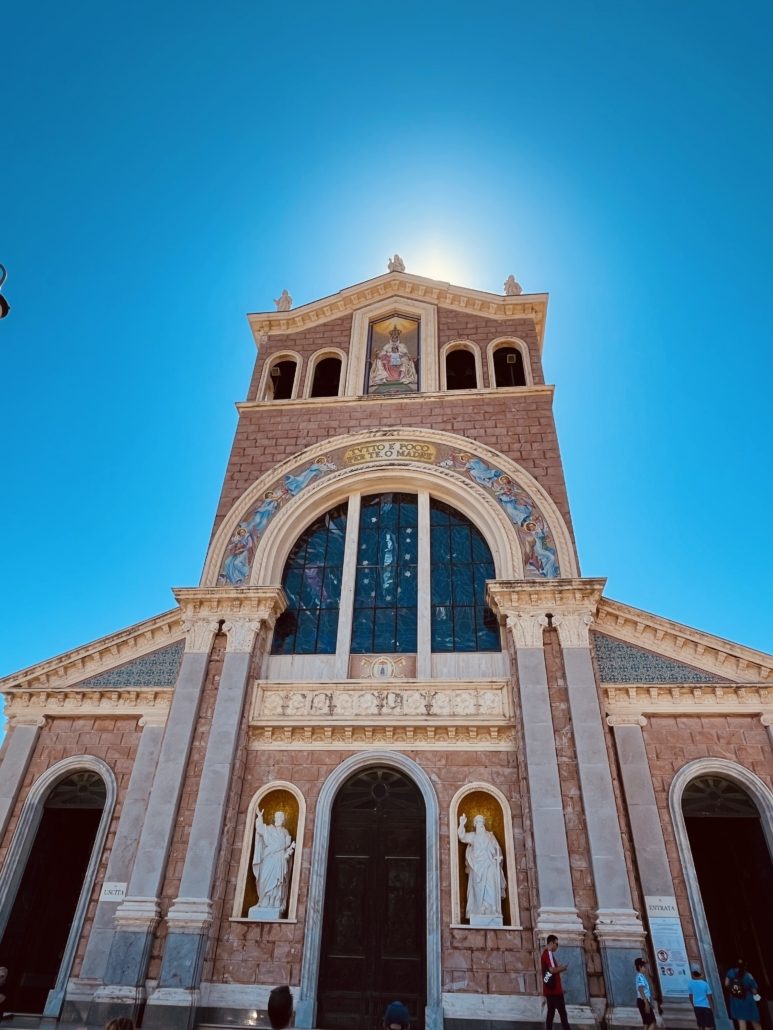
The Black Madonna’s sanctuary was perched atop a cliff overlooking the Mediterranean Sea. After getting over the shock of all the gaudy tourist attraction stalls and souvenirs leading up to her holy place, I was able to turn my attention to the beauty of the architecture of this temple and how many precious metals and mosaics and stained glass had gone into creating it. Once inside, I was magnetized to the front pew and got lost in prayer in a way that is hard for me to do in my day to day. I came out of those prayers forgetting for a moment where I was, and dazed if I had been in there one hour or several. There was no question about it- I was in the arms of the Holy Mother and felt deeply soothed.
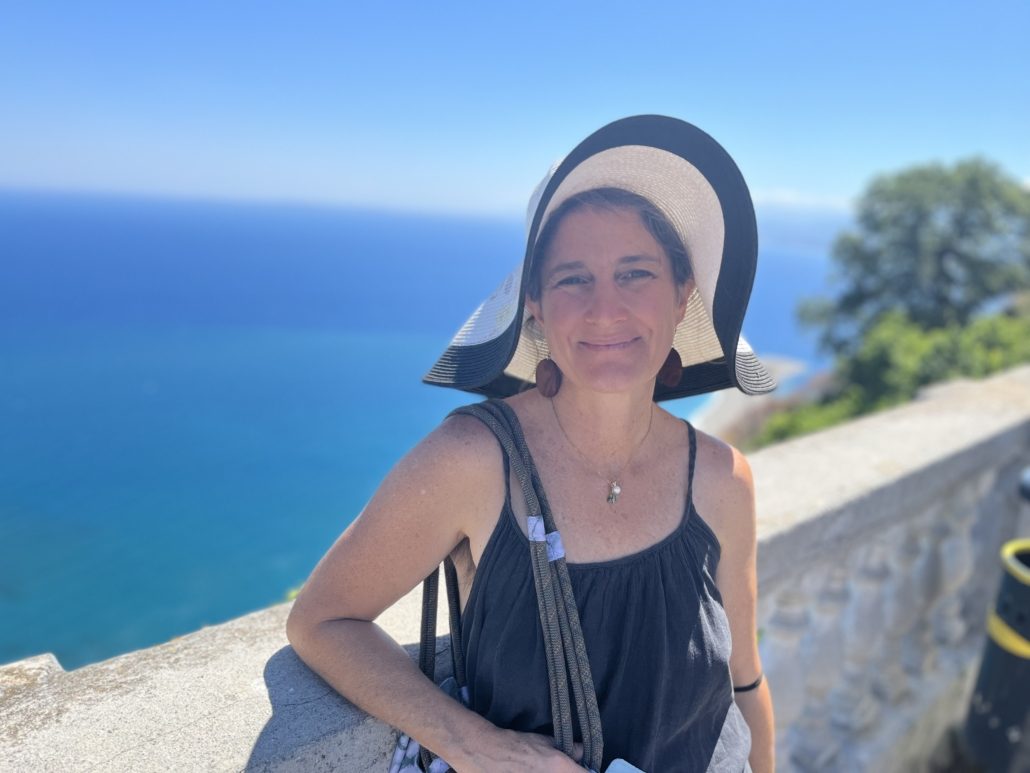
In front of Black Madonna of Tindari’s Sanctuary
Down below, I straddled swimming between the lakes that were up against the cliffs, and the sea which was a few footsteps from the lakes. In and out of both, I felt healed and renewed of burdens I had been carrying.
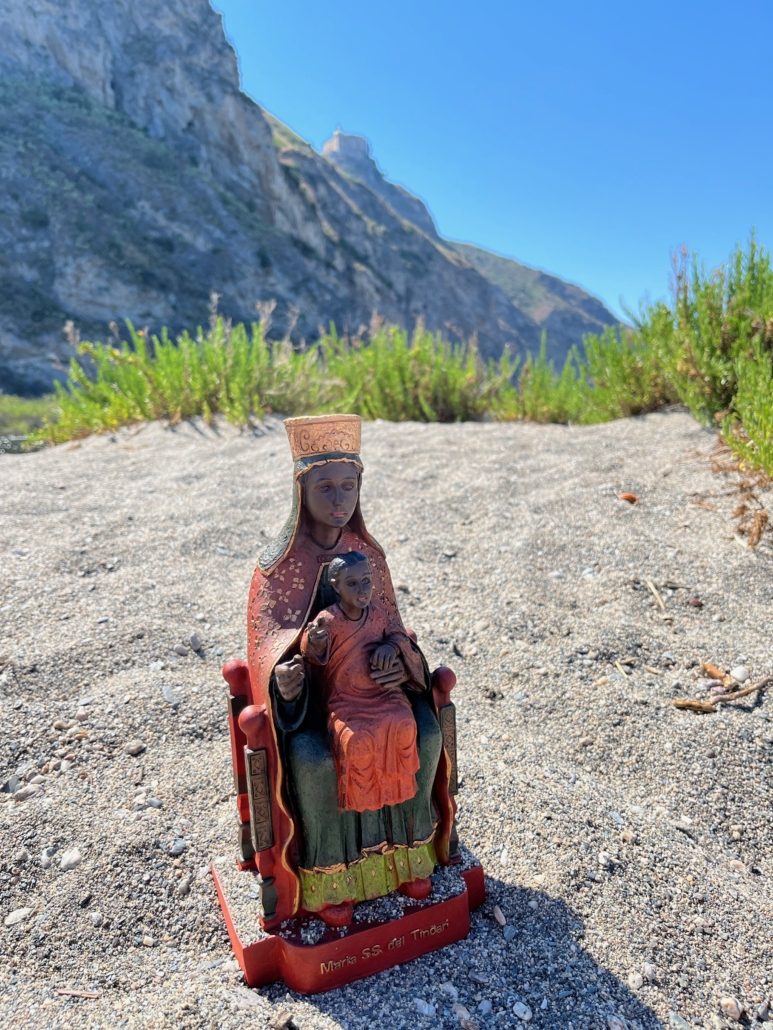
A statue of the Black Madonna with her sanctuary perched on the cliff above, hanging out between lakes and sea.
Jade led us into the nature preserve for a plant walk and introduced us to Helichrysum stoechas, upon which I went giddy with joy! Finally, I was meeting Helichrysum- thank you, Jade, for this surprising introduction!! Then there was this Mullein with such bizarre leaves. Verbascum sinuatum or Candelora regilla as it is called in Sicilian. We touched Sea Fennel and Sea lavender, and felt Horn Poppy’s (Glauchium flavum) fuzzy leaves. Jade spoke to the mystery and the play of Phragmites that marched along the sand.
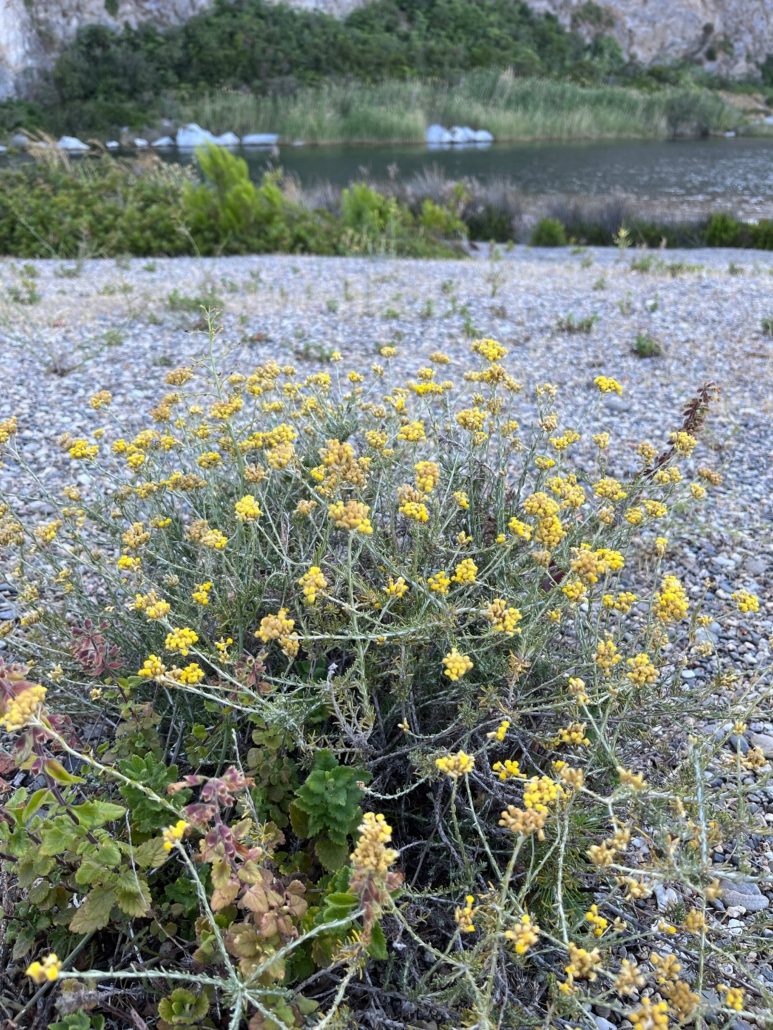
Helichrysum stoechas
We even got to do some interstellar travels on the trip and went to Venus’s Pools. OOOhhh lots of life in these shallows, where the silver leaf nightshade and caper and carnation grew along the path down to her slippery, vibrant holes. It was the perfect way to conclude such a dynamic adventure of soil and soul and water and emotion.
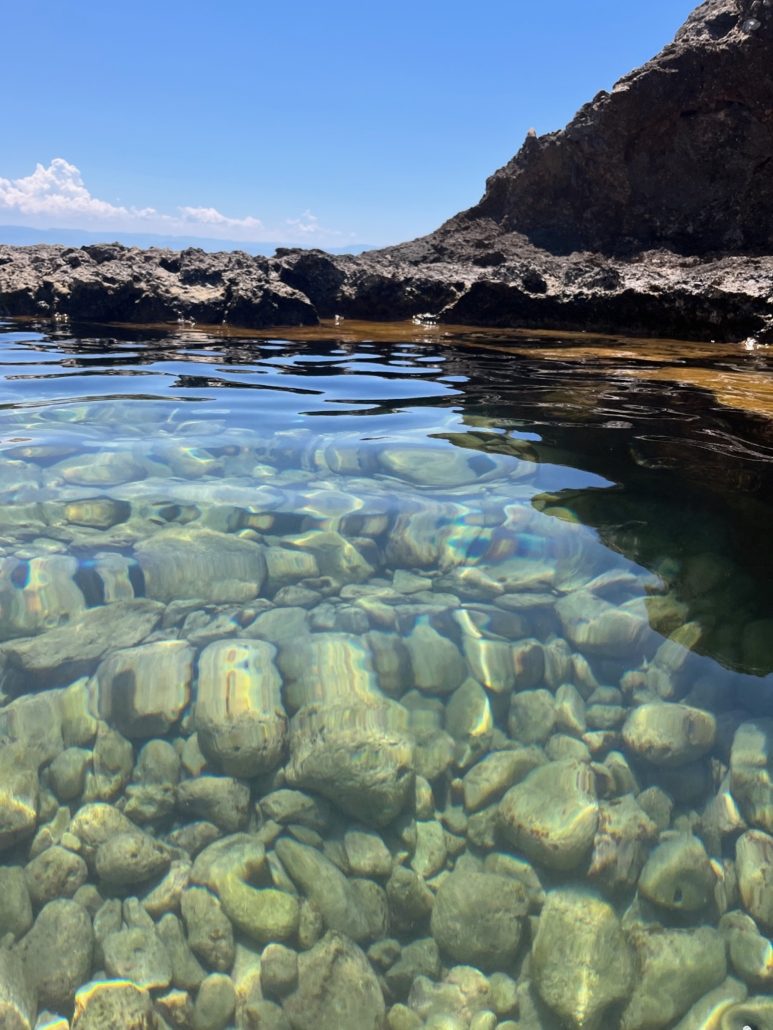
On the way back to the airport in Catania, where we began, I said goodbyes to my green friends—Bear’s Breeches, Wild Fennel and Cardoon, Centaria, Cottonwood, Cypress, Malva, Geraniums, Agave, Hawthorne, Rose, Cane, Wild Garlic and Onion, Juniper, Cherry’s and Thistles of all kinds. It was a full moon and with sweet sadness, I bid my new human friends and this amazing country, Farewell~
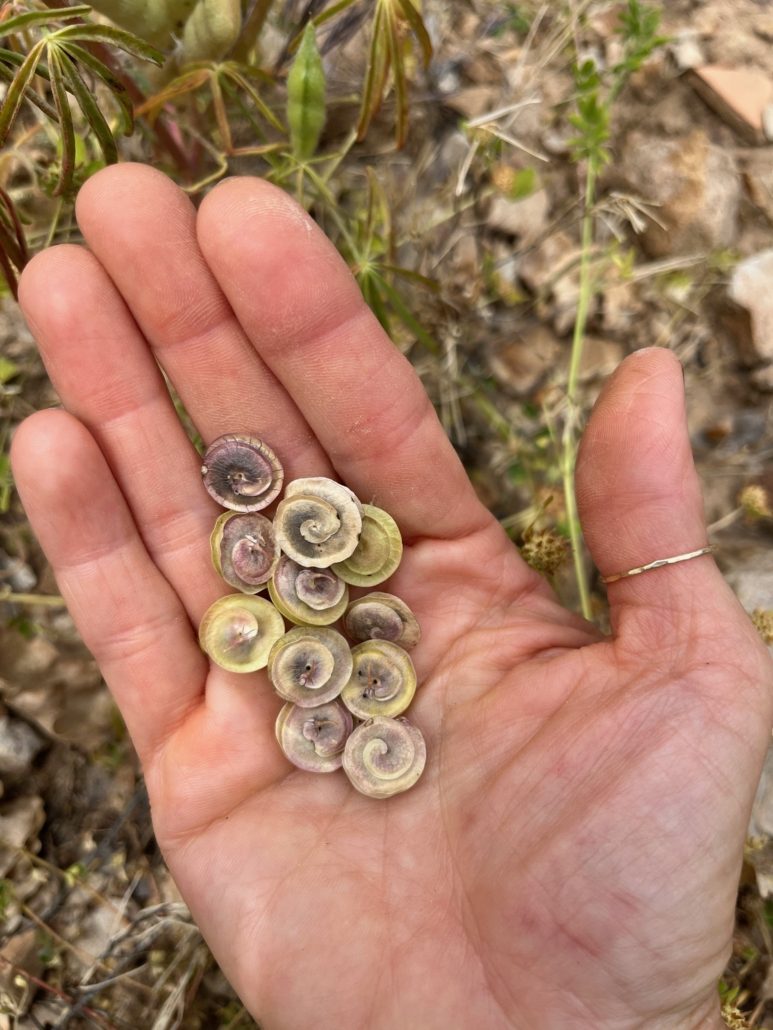
Seeds of Alfalfa

Tree Wormwood, Artemisia arborescens
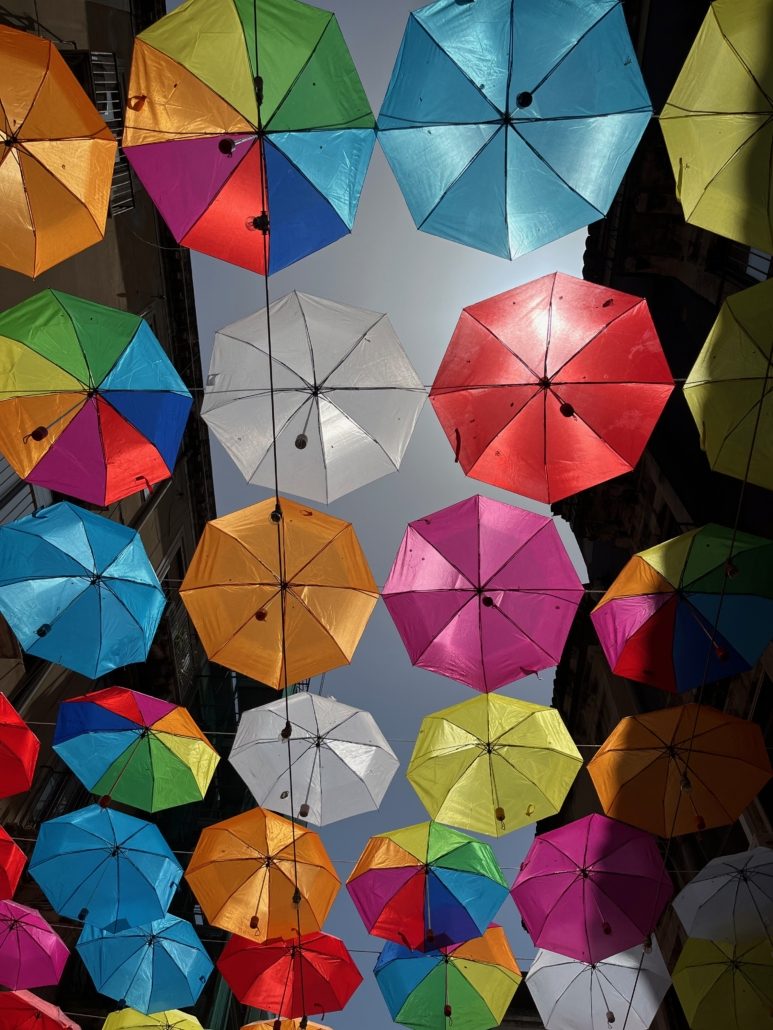
A Catania street
*Big Thank You to the group who so generously shared some of these pictures that I have used in this blog

